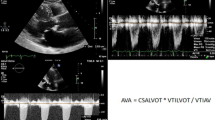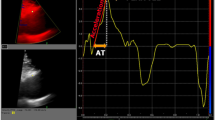Abstract
Decreased coaptation height in adults has been identified as a marker of early valve failure. We evaluated aortic valve coaptation and effective height in healthy children and in children with a ventricular septal defect (VSD) with aortic cusp prolapse (ACP), using echocardiography. We included 45 subjects with VSD with ACP, 27 did not develop aortic regurgitation (AR) by ACP and 18 developed AR by ACP, and 83 healthy children as controls. Aortic root anatomy was estimated using the parasternal long-axis view. We measured the diameter of aortic valve (AV), coaptation height (CH), and effective height (EH) of the aortic valve. We defined the ACH (CH/AV ratio) and AEH (EH/AV ratio) indices as follows: \(\text{ACH }\!\!~\!\!\text{ index}\left( \text{ }\!\!\%\!\!\text{ } \right)\text{= }\!\!~\!\!\text{ }\frac{\text{CH}}{\text{AV}}\text{ }\!\!\times\!\!\text{ 100, AEH }\!\!~\!\!\text{ index}\left( \text{ }\!\!\%\!\!\text{ } \right)\text{= }\!\!~\!\!\text{ }\frac{\text{EH}}{\text{AV}}\text{ }\!\!\times\!\!\text{ 100}\). There were significant differences in ACH and AEH between the groups (control vs VSD with ACP vs VSD with ACP and AR, median ACH [%], 35.1 vs 32.0 vs 22.1; median AEH [%], 52.0 vs 48.0 vs 34.4, respectively; P < 0.01]). Intra-cardiac repair (ICR) was performed in 15 cases. Significant increases were observed in ACH and AEH before and after ICR (median ACH [%], before: 27.0, after: 32.7, P < 0.05; median AEH (%), before 38.5, after 45.8, P < 0.05). Measurement of ACH and AEH may allow direct and non-invasive assessment of the severity of VSD with ACP, which could aid clinicians in determining the need and timing for surgical intervention.



Similar content being viewed by others
References
Lun K, Li H, Leung MP, Chau AK, Yung T, Chiu CS et al (2001) Analysis of indications for surgical closure of subarterial ventricular septal defect without associated aortic cusp prolapse and aortic regurgitation. Am J Cardiol 87:1266
Momma K, Toyama K, Takao A, Ando M, Nakazawa M, Hirosawa K et al (1984) Natural history of subarterial infundibular ventricular septal defect. Am Heart J 108:1312–1317
Leung MP, Beerman LB, Siewers RD, Bahnson HT, Zuberbuhler JR (1987) Long-term follow-up after aortic valvuloplasty and defect closure in ventricular septal defect with aortic regurgitation. Am J Cardiol 60:890–894
Tohyama K, Satomi G, Momma K (1997) Aortic valve prolapse and aortic regurgitation associated with subpulmonic ventricular septal defect. Am J Cardiol 79:1285–1289
Tatsuno K, Konno S, Ando M, Sakakibara S (1973) Pathogenic mechanism of prolapsing aortic valve and aortic regurgitation associated with ventricular septal defect: anatomical, angiographic and surgical consideration. Circulation 48:1028–1037
Soto B, Becker AE, Moulaert AJ, Lie JT, Anderson RH (1980) Classification of ventricular septal defects. Br Heart J 43:332
Ando M, Takao A (1986) Pathological anatomy of ventricular septal defect associated with aortic valve prolapse and regurgitation. Heart Vessels 2:117
Bierbach BO, Aicher D, Issa OA, Bomberg H, Gräber S, Glombitza P et al (2010) Aortic root and cusp configuration determine aortic valve function. Eur J Cardio-thoracic Surg 38:400–406
Roman MJ, Devereux RB, Kramer Fox R, O’Loughlin J (1989) Two-dimensional echocardiographic aortic root dimensions in normal children and adults. Am J Cardiol 64:507–512
Kunzelman KS, Grande KJ, David TE, Cochran RP, Verrier ED (1994) Aortic root and valve relationships. Impact on surgical repair. J Thorac Cardiovasc Surg 107:162–170
Poutanen T, Tikanoja T, Sairanen H, Jokinen E (2003) Normal aortic dimensions and flow in 168 children and young adults. Clin Physiol Funct Imaging 23:224–229
Swanson M, Clark RE (1974) Dimensions and geometric relationships of the human aortic valve as a function of pressure. Circ Res 35:871–882
Schäfers HJ, Bierbach B, Aicher D (2006) A new approach to the assessment of aortic cusp geometry. J Thorac Cardiovasc Surg 132:436–438
Zoghbi WA, Enriquez-Sarano M, Foster E, Grayburn PA, Kraft CD, Levine RA, Nihoyannopoulos P et al (2003) Recommendations for evaluation of the severity of native valvular regurgitation with two-dimensional and doppler echocardiography. J Am Soc Echocardiogr 16:777–802
Pettersen MD, Du W, Skeens ME, Humes RA (2008) Regression equations for calculation of Z scores of cardiac structures in a large cohort of healthy infants, children, and adolescents: an echocardiographic study. J Am Soc Echocardiogr 21:922–934
Van Praagh R, McNamara JJ (1968) Anatomic types of ventricular septal defect with aortic insufficiency. Diagnostic and surgical considerations. Am Heart J 175:604–619
Yacoub MH, Khan H, Stavri G, Shinebourne E, Radley-Smith R (1997) Anatomic correction of the syndrome of prolapsing right coronary aortic cusp, dilatation of the sinus of valsalva, and ventricular septal defect. J Thorac Cardiovasc Surg 113:253–261
de Leval MR, Pozzi M, Starnes V, Sullivan ID, Stark J, Somerville J et al (1998) Surgical management of doubly committed subarterial ventricular septal defects. Circulation 78(suppl III):III40–III46
Roman MJ, Devereux RB, Niles NW, Hochreiter C, Kligfield P, Sato N et al (1987) Aortic root dilatation as a cause of isolated, severe aortic regurgitation. Prevalence, clinical and echocardiographic patterns, and relation to left ventricular hypertrophy and function. Ann Intern Med 106:800–807
Shapiro LM, Thwaites B, Westgate C, Donaldson R (1985) Prevalence and clinical significance of aortic valve prolapse. Br Heart J 54:179–183
Thubrikar MJ, Labrosse MR, Zehr KJ, Robicsek F, Gong GG, Fowler BL (2005) Aortic root dilatation may alter the dimensions of the valve leaflets. Eur J Cardiothorac Surg 28:850–855
Langer F, Graeter T, Nikoloudakis N, Aicher D, Wendler O, Schäfers HJ (2001) Valve-preserving aortic replacement: does the additional repair of leaflet prolapse adversely affect the results? J Thorac Cardiovasc Surg 122:270–277
Zarate YA, Sellars E, Lepard T, Carlo WF, Tang X, Collins RT II (2015) Aortic dilation in pediatric patients. Eur J Pediatr 174:1585–1592
Kelleher CM, McLean SE, Mecham RP (2004) Vascular extracellular matrix and aortic development. Curr Top Dev Biol 62:153–188
Parks WC, Roby JD, Wu LC, Grosso LE (1992) Cellular expression of tropoelastin mRNA splice variants. Matrix 12:156–162
Tomita H, Arakaki Y, Ono Y, Yamada O, Yagihara T, Echigo S (2005) Impact of noncoronary cusp prolapse in addition to right coronary cusp prolapse in patients with a perimembranous ventricular septal defect. Int J Cardiol 101:279–283
Komai H, Naito Y, Fujiwara K, Noguchi Y, Nishimura Y, Uemura S (1997) Surgical strategy for doubly committed subarterial ventricular septal defect with aortic cusp prolapse. Ann Thorac Surg 64:1146–1149
Hitchcock JF, Suijker WJL, Ksiezycka E, Harinck E, van Mill GJ, Ruzyllo W et al (1991) Management of ventricular septal defect with associated aortic incompetence. Ann Thorac Surg 52:70–73
Santini F, Mazzucco A (1997) Timing of surgical closure of subpulmonary ventricular septal defect in infancy. Am J Cardiol 80:976–97730
Backer CL, Winters RC, Zales VR, Takami H, Muster AJ, Benson DW Jr et al (1993) Restrictive ventricular septal defect: how small is too small to close? Ann Thorac Surg 56:1014–1019
Gabriel HM, Heger M, Innerhofer P, Zehetgruber M, Mundigler G, Wimmer M et al (2002) Long-term outcome of patients with ventricular septal defect considered not to require surgical closure during childhood. J Am Coll Cardiol 39:1066–1071
Menting ME, Cuypers JA, Opić P, Utens EM, Witsenburg M, van den Bosch AE et al (2015) The unnatural history of the ventricular septal defect: outcome up to 40 years after surgical closure. J Am Coll Cardiol 65:1941–1951
Chiu SN, Wang JK, Lin MT, Chen CA, Chen HC, Chang CI et al (2007) Progression of aortic regurgitation after surgical repair of outlet-type ventricular septal defects. Am Heart J 153:336–342
Cheung YF, Chiu CS, Yung TC, Chau AK (2002) Impact of preoperative aortic cusp prolapse on long-term outcome after surgical closure of subarterial ventricular septal defect. Ann Thorac Surg 73:622–627
van Son JA, Danielson GK, Schaff HV, Orszulak TA, Edwards WD, Seward JB (1994) Long-term outcome of surgical repair of ruptured sinus of Valsalva aneurysm. Circulation 90:20–29
le Polain de Waroux JB, Pouleur AC, Robert A, Pasquet A, Gerber BL, Noirhomme P et al (2009) Mechanisms of recurrent aortic regurgitation after aortic valve repair: predictive value of intraoperative transesophageal echocardiography. JACC Cardiovasc Imaging 2:931–939
Stern KW, White MT, Verghese GR, Del Nido PJ, Geva T (2015) Intraoperative echocardiography for congenital aortic valve repair: predictors of early reoperation. Ann Thorac Surg 100:678–685
Author information
Authors and Affiliations
Corresponding author
Ethics declarations
Conflict of interest
The authors report no conflicts of interest. The authors alone are responsible for the content and writing of this article.
Ethical standard
This study was approved by the Ethics Committee of the respective institutions and conducted according to the principles of the Declaration of Helsinki.
Rights and permissions
About this article
Cite this article
Iwashima, S., Uchiyama, H., Ishikawa, T. et al. Measurement of Aortic Valve Coaptation and Effective Height Using Echocardiography in Patients with Ventricular Septal Defects and Aortic Valve Prolapse. Pediatr Cardiol 38, 608–616 (2017). https://doi.org/10.1007/s00246-016-1555-8
Received:
Accepted:
Published:
Issue Date:
DOI: https://doi.org/10.1007/s00246-016-1555-8




